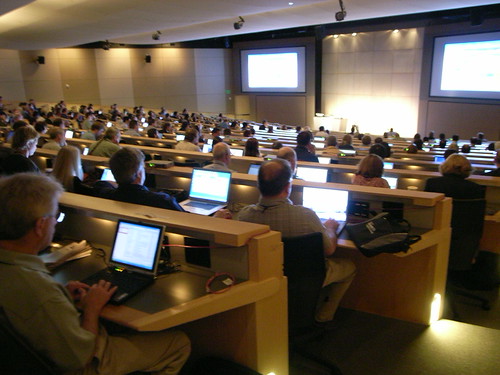Funding Opportunities from the National Science Foundation CreativeIT Program
http://www.nsf.gov/funding/pgm_summ.jsp?pims_id=501096&org=CISE&from=home
DUE DATE
Full Proposal Deadline Date: October 13, 2009
I. INTRODUCTION
Creativity, design, and research all contribute new knowledge and artifacts. The CreativeIT program focuses on the commonality of these three processes and solicits proposals that bring creative practice and creativity research to play a role in transformative research in specific contexts of computer science, cognitive science, information technology, education, engineering design and science. The program considers design as a type of research in which the definition of the problem may change in response to the exploration and development of alternative solutions, leading to creative solutions and innovation. The program’s objective is to bring together different disciplines associated with creative and scientific advances in a way that is mutually beneficial. This program encourages new ways of thinking about one discipline in terms of another, so that the interdisciplinary nature of the project is a means to an end rather than an end in itself.
II. PROGRAM DESCRIPTION
Information technology is playing an increasing role in extending the capability of human creative thinking and problem solving, and conversely, creative uses of information technology are leading to new areas of research and innovation. Creativity is often the result of a design process in which the exploration of possible designs changes our perspective on what the design can or should achieve. A designer develops new artifacts in the context of a perceived need or problem specification. In creative design, the reflection on problem finding becomes as important as problem solving. The combination of creativity and design thinking in information technology, science, and engineering has the potential to define new areas and lead to increased successful innovation. Advances: CreativeIT seeks proposals for projects whose objectives are new models of creativity, new models for research and education, or creativity enhancing tools developed in the context of a specific discipline.
Research Areas: The following research areas elaborate on these potential types of advances as guidelines for describing how the objectives of the project contribute to CreativeIT.
Understanding Creative Cognition and Computation. Research in this area develops or applies cognitive models that serve as inspiration for computational models of creativity, support for human creativity, or approaches for educating people to be more creative. This research is typically done by adopting or adapting a model of cognition and evaluating its creative performance in different contexts, or developing a new model of creativity based on empirical or ethnographic studies. The emphasis in this area is the development of new models of cognition and computation that explain or simulate creativity and how these models open up new research areas in computing and cognitive science.
Creativity to Stimulate Breakthroughs in Science and Engineering. This area considers the role and performance of creative professionals in developing new technologies, discovering new patterns in information, and in finding new ways of seeing, knowing, and doing computing, science and engineering. This area seeks to foster research that is conducted with groups of people from different backgrounds in which the creative synergy is focused on a specific context, problem, or perceived need. The result of this research is a new product, new model, or new area of research. The evaluation of the results of this kind of research does not follow directly from existing metrics or performance criteria and therefore may need to redefine relevant performance criteria.
Educational Approaches that Encourage Creativity. This area considers a broad range of approaches to learning that encourages creativity: multi-disciplinary teaching and learning, design studio environments, skills development through making and doing, serious games, and open-ended problem-based learning. This area includes the development and evaluation of innovative computational environments for learning that reward creativity leading to transformative changes in curriculum objectives and structure.
Supporting Creativity with Information Technology. This area develops new software and interaction design to support people in being more creative and evaluates their performance through user studies either in controlled environments with empirical studies or in the context of a complex problem or situation with ethnographic studies. The emphasis in this area is the development of new computing environments where the environment itself may be a creative product, and the environment is intended to support people in their creative activities.
[Wow. Really? This sounds more like an EU or Canadian art-tech-society RFP than the NSF I know. Looks quite promising, at least in the principles outlined. What’s up with the photo above? This was the Microsoft Faculty Research Summit a couple summers ago, where an announcement was made that chilled me bones — more pure CS research support from the NSF. I’m not hatin’ here, it’s just this turn towards purity rather than hybridity that I heard. Rather than considering the complexities of creating awesome people-focused design technologies, it sounded like it was back to files, folders algorithms and data. I don’t know if the NSF remit has changed any in the new administration, but this RFP is at least a bit of palette cleanser.]
Continue reading National Science Foundation Creative "IT" RFP
